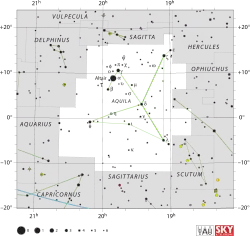
| |
| Observation data Epoch J2000 Equinox J2000 | |
|---|---|
| Constellation | Aquila |
| Right ascension | 19h 51m 01.64400s[1] |
| Declination | +10° 24′ 56.5992″[1] |
| Apparent magnitude (V) | 5.11[2] |
| Characteristics | |
| Spectral type | F8 V + M3 V[3] |
| U−B color index | 0.07 |
| B−V color index | 0.55[4] |
| R−I color index | 0.29 |
| Astrometry | |
| Radial velocity (Rv) | –0.2[5] km/s |
| Proper motion (μ) | RA: +242.28[1] mas/yr Dec.: –136.48[1] mas/yr |
| Parallax (π) | 52.11 ± 0.29 mas[1] |
| Distance | 62.6 ± 0.3 ly (19.2 ± 0.1 pc) |
| Absolute magnitude (MV) | 3.71[5] |
| Details | |
| ο Aql A | |
| Mass | 1.252[6] M☉ |
| Radius | 1.52[6] R☉ |
| Surface gravity (log g) | 4.07[7] cgs |
| Temperature | 6,090[7] K |
| Metallicity [Fe/H] | +0.07[7] dex |
| Rotational velocity (v sin i) | 3[4] km/s |
| Age | 3.3[5] Gyr |
| ο Aql C | |
| Mass | 0.33[8] M☉ |
| Other designations | |
| Database references | |
| SIMBAD | data |
Omicron Aquilae (ο Aql, ο Aquilae) is the Bayer designation for a double star in the equatorial constellation of Aquila. The brighter component has an apparent visual magnitude of +5.11,[2] which means it is faintly visible to the naked eye in dark suburban skies. The annual parallax shift of this star is 52.11 mas,[1] which is equivalent to a physical distance of 62.6 light-years (19.2 parsecs) from Earth.
The primary component, Omicron Aquilae A, is an F-type main sequence star with a stellar classification of F8 V.[3] It has about 125% of the mass of the Sun and 152% of the Sun's radius.[6] With an age of roughly 3.3 billion years,[5] it appears to spinning at a leisurely rate with a projected rotational velocity of 3 km/s.[4] The outer atmosphere has an effective temperature of 6,090 K,[7] giving it the yellowish-white hue of an F-type star.
In 1998, Omicron Aquilae was one of nine stars identified as experiencing a superflare. The first flare observed from Omicron Aquilae was in 1979, with a magnitude increase of 0.07 and a duration of less than five days. The second occurred in 1980, with a magnitude change of 0.09 and a duration of fifteen days. The energy released during the second flare is estimated as 9 × 1037 erg.[10]
There is a magnitude 12.67 common proper motion companion located at an angular separation of 22.5 arcseconds along a position angle of 221°. Based upon its matching parallax value, this corresponds to a projected separation of 431 astronomical units. (Hence, the companion is located at this separation or greater.) Designated component C, this is a small red dwarf star with a stellar classification of M3 V. Component B is an optical companion that appears near the primary only through a chance alignment.[3]
References
- 1 2 3 4 5 6 van Leeuwen, F. (November 2007), "Validation of the new Hipparcos reduction", Astronomy and Astrophysics, 474 (2): 653–664, arXiv:0708.1752, Bibcode:2007A&A...474..653V, doi:10.1051/0004-6361:20078357, S2CID 18759600.
- 1 2 Nicolet, B. (1978), "Photoelectric photometric Catalogue of homogeneous measurements in the UBV System", Astronomy and Astrophysics Supplement Series, 34: 1–49, Bibcode:1978A&AS...34....1N.
- 1 2 3 Raghavan, Deepak; et al. (September 2010), "A Survey of Stellar Families: Multiplicity of Solar-type Stars", The Astrophysical Journal Supplement, 190 (1): 1–42, arXiv:1007.0414, Bibcode:2010ApJS..190....1R, doi:10.1088/0067-0049/190/1/1, S2CID 368553.
- 1 2 3 Takeda, Yoichi; et al. (February 2005), "High-Dispersion Spectra Collection of Nearby F--K Stars at Okayama Astrophysical Observatory: A Basis for Spectroscopic Abundance Standards", Publications of the Astronomical Society of Japan, 57 (1): 13–25, Bibcode:2005PASJ...57...13T, doi:10.1093/pasj/57.1.13.
- 1 2 3 4 Holmberg, J.; Nordström, B.; Andersen, J. (July 2009), "The Geneva-Copenhagen survey of the solar neighbourhood. III. Improved distances, ages, and kinematics", Astronomy and Astrophysics, 501 (3): 941–947, arXiv:0811.3982, Bibcode:2009A&A...501..941H, doi:10.1051/0004-6361/200811191, S2CID 118577511.
- 1 2 3 Takeda, Genya; et al. (February 2007), "Structure and Evolution of Nearby Stars with Planets. II. Physical Properties of ~1000 Cool Stars from the SPOCS Catalog", The Astrophysical Journal Supplement Series, 168 (2): 297–318, arXiv:astro-ph/0607235, Bibcode:2007ApJS..168..297T, doi:10.1086/509763, S2CID 18775378.
- 1 2 3 4 Frasca, A.; et al. (December 2009), "REM near-IR and optical photometric monitoring of pre-main sequence stars in Orion. Rotation periods and starspot parameters", Astronomy and Astrophysics, 508 (3): 1313–1330, arXiv:0911.0760, Bibcode:2009A&A...508.1313F, doi:10.1051/0004-6361/200913327, S2CID 118361131.
- ↑ Bonavita, M.; Desidera, S. (June 2007), "The frequency of planets in multiple systems", Astronomy and Astrophysics, 468 (2): 721–729, arXiv:astro-ph/0703754, Bibcode:2007A&A...468..721B, doi:10.1051/0004-6361:20066671, S2CID 18907128.
- ↑ "omi Aql". SIMBAD. Centre de données astronomiques de Strasbourg. Retrieved 2012-06-29.
- ↑ Schaefer, Bradley E.; King, Jeremy R.; Deliyannis, Constantine P. (February 2000), "Superflares on Ordinary Solar-Type Stars", The Astrophysical Journal, 529 (2): 1026–1030, arXiv:astro-ph/9909188, Bibcode:2000ApJ...529.1026S, doi:10.1086/308325, S2CID 10586370